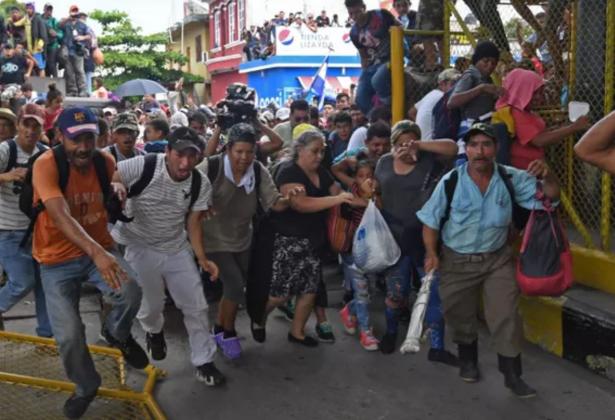Thousands of Central American migrants have defied Donald Trump and streamed over the international bridge from Guatemala into Mexico, where some clashed with riot police in an attempt to continue their journey north.
Singing the Honduran national anthem and chanting “Yes we could!”, the crowd of about 3,000 people – including entire families pushing wheelchairs and strollers – walked across the bridge over the muddy Suchiate river on Friday afternoon.
Locals cheered and handed out bottles of water, while Guatemalan police officers stood to the side of the road and watched the migrants pass.
Ivys Osorio, 31, said he was trying to return to Houston, where he lived for 16 years before he was deported in 2016 – and where his wife still lives. “I thought they weren’t going to let us cross – but now I feel getting closer to her,” he said.
An army helicopter hovered on the northern bank of the river, some at the front crowd clashed with a line of Mexican police with riot shields, who fired pepper spray at the migrants.A few dozen migrants managed to push past, but most of the crowd formed lines on the bridge as they waited to be processed by Mexican migration officials.
The dramatic scenes came a week after a group of migrants set out from the Honduran city of San Pedro Sula, to escape crushing poverty and the violence which has turned their country into one of the most dangerous nations in the world.
The exhausted marchers had spent the night under rainy skies on the streets and in a park in the border town of Tecún Umán, where the shelter for migrants and a local Catholic parish were filled to capacity.
Few were aware of Trump’s attempts to deter the caravan with threats to cut aid payments and deploy troops on the US border.
“I think he’s just trying to scare people,” said Heidy Bonilla, 19, rocking her six-month old son, Jeyden. Bonilla had joined the caravan with her mother Mayra, 52; both women were – like many female migrants – trying to escape domestic violence.
“God has the final word – only he can decide what happens next.”
What awaited them across the border was uncertain.
Mexico’s government has said only migrants with the proper papers will be allowed entry into the country, although anyone wishing to seek asylum was free to do so. In Tecún Umán on Friday morning, representatives from the UN refugee agency were handing out leaflets explaining how to claim refugee status in Mexico.
Mexico received 14,596 claims in 2017 – more than a six-fold increase from 2014 – but half of the claims made last year are still unresolved, prompting the National Human Rights Commission to warn of the “pending collapse of the refugee protection system in Mexico”.
Mexico appeared to be attempting to avoid a rerun of a previous caravan of migrants, which formed over Easter and swelled in size, capturing the attention of conservative US media – and Trump.
One of that caravan’s organisers, Irineo Mujica, a dual US-Mexican citizen, was arrested during a peaceful protest on Thursday. Video on social media showed him being stuffed into an immigration institute van as protesters resisted.
Late on Thursday, Trump retweeted a video of Mexican federal police arriving at the Guatemalan border and wrote: “Thank you Mexico, we look forward to working with you!”
But for many in the caravan, Trump’s hostility seemed illogical.
“Latinos are the base of the USA; he needs people like us,” said Carlos Orellana, 23, who said he was heading north in search of employment as a welder.
Illegal immigration to the US from Mexico is much lower than in the early 2000s, but growing numbers of families are fleeing the “northern triangle” of Guatemala, Honduras and El Salvador to escape poverty, violence and the early effects of climate change.
Carlos Omar Caballeros, 48 was travelling with his 17-year-old daughter who didn’t want to be named because they were fleeing threats and extortion by one of the many street gangs that dominate the region.
He was scornful at Trump’s threat to withhold aid to the Honduran government of President Juan Orlando Hernández, who was re-elected in December amid allegations of widespread electoral fraud. Like many Hondurans, Caballeros blames the US for supporting the 2009 military coup against the country’s elected government.
“They destabilise our country, wreck our economy, and protect the corrupt, who keep all the money the US sends. We don’t care if they stop the aid – we never see any of it,” he said.
Caballeros ran his hand through his white hair, then wiped tears of anger from his face. “All we want is to get out of that hell we were living in San Pedro ,” he said.
David Agren has covered Mexico since 2005 for publications including the Guardian, USA Today and Maclean's magazine. He also works as Mexico correspondent for the Committee to Protect Journalists.


Spread the word